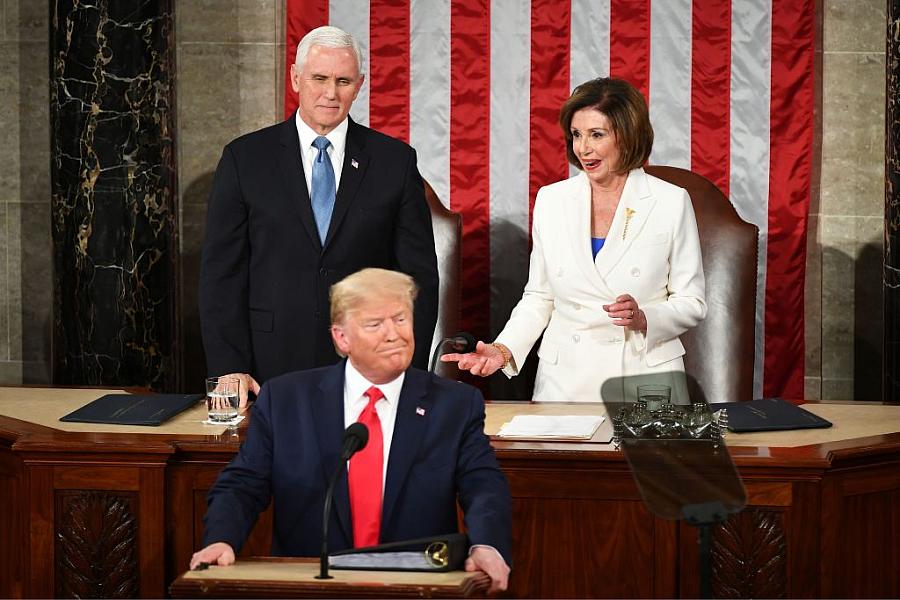Preexisting conditions once again hang in the balance this election season

(Photo by Mandel Ngan/AFP via Getty Images)
If the Affordable Care Act taught us anything, it’s that most Americans want everyone to have access to health insurance, even if they are already sick. That was a huge step forward in the country’s thinking about its health insurance arrangements, and it was obvious in 2017 Congressional town halls and in the 2018 midterm elections, when health care topped the list of voters’ priorities. If Obamacare survives, coverage for preexisting conditions will indeed be a crucial part of its legacy.
In his State of the Union message Tuesday, President Donald Trump seemed to agree when he said, “I have made an ironclad pledge to American families: We will always protect patients with preexisting conditions — that is a guarantee.”
Really? The actions the Trump administration has taken may end up doing just the opposite, and once again sick people will return to the Dark Ages of health insurance, when even those with minor afflictions — like kids prone to ear infections — could be denied insurance. The administration is supporting legal challenges to the Affordable Care Act brought by Republican state attorneys general that could ultimately result in throwing out the entire law, including its prohibitions on restricting coverage to the sick.
Six out of 10 Iowa caucus goers said they supported a “Medicare for All” solution to health insurance, The Washington Post reported. That’s a strong indication of interest in changing the American system of health coverage. The challenge for journalists going forward is to follow whether the president’s grandiose guarantees in his State of the Union address are for real and to explain with great clarity and insight how the two major approaches — single-payer or public option — will address the fundamental question now on shaky ground: Do sick people in America deserve guaranteed health coverage?
Preexisting conditions and the basic insurance principle called “adverse selection” are at the core of the two broad proposals being discussed. Adverse selection means that a lot of undesirable risks, in this case sick people, sign up for coverage. Insurers pay out more claims, premiums rise, and an insurance carrier or a particular product may become unprofitable if they pay out more than they take in.
Under the public option proposed by some Democrats, people can choose either private insurance or a government-backed plan. That could result in a smaller risk pool. The danger, of course, is that mostly sick people would sign up for coverage.
With a Medicare for All system that would guarantee health coverage to everyone as a matter of right, adverse selection wouldn’t be much of a problem. The more people who are in the pool — healthy and sick — the less likely adverse selection becomes. Because there are greater numbers of healthier people who pay premiums, they help cover the cost of the sick. And when those healthy people get sick themselves, as most inevitably do, other healthy people in the pool help cover their expenses. It’s a kind of mutual subsidization that’s integral to foreign health systems and to our own Medicare program.
Under the public option proposed by some Democrats, people can choose either private insurance or a government-backed plan. That could result in a smaller risk pool — much smaller than, say, it is under the traditional Medicare program. The danger, of course, is that mostly sick people would sign up for coverage. There would be many fewer people in the risk pool, and they may be disproportionately sick.
In a recent article published in the Annals of Internal Medicine (I’ve mentioned before this should be required reading for reporters covering this topic), Drs. Steffie Woolhandler and David Himmelstein argue for a single-payer plan along the lines of Medicare for All over the public option for several reasons. They cite the experience of the health insurance co-ops set up under the Affordable Care Act. Almost all of them have gone out of business, largely because they did not have enough resources to cover the claims of all the very sick people who signed up. They also cite the experience of Medicare Advantage plans, some of which are eager to dump their customers who turn out to be sick and cost them a lot of money. They are called “lemon drops” in the business.
Depending on how a public option is structured, it might experience the same problems. If is not well designed, it could become a self-destructing mess.
The point of this little insurance history lesson is not to scare reporters into taking a pass on coverage because Beltway elites have thrown up their hands and concluded change will never happen. It is to encourage journalists to be rigorous and well-informed on health care policy as the election season moves forward. Those reporting on the public option need to ask the tough questions about how proponents intend to deal with risk pools and adverse selection. How can it bypass the fatal errors of the past and become a valid option? As for the more inclusive Medicare for All option, we need to move beyond the political talking points that it is too expensive or disruptive and inexorably leads us to socialism. No one I know is talking about a government takeover of the hospitals and medical practices. A discussion of realistic financing options is in order, one that draws on lessons from existing health systems in other countries.
And perhaps most immediate is to continue to question the president’s “ironclad” State of the Union claim that he’ll ensure those with preexisting conditions can get coverage. Americans’ skepticism about that larger point is one reason Republicans got hammered in the 2018 midterms. If that basic insurance protection falls, we will be back at square one.
Veteran health care journalist Trudy Lieberman is a contributing editor at the Center for Health Journalism Digital and a regular contributor to the Remaking Health Care column.

